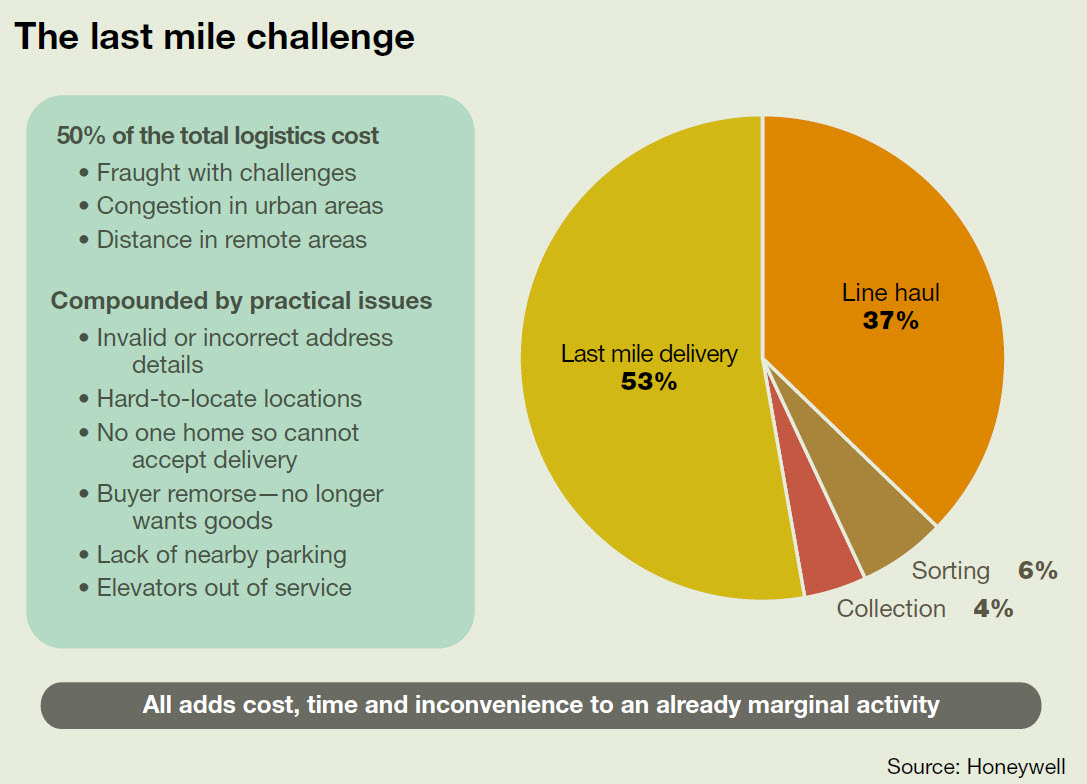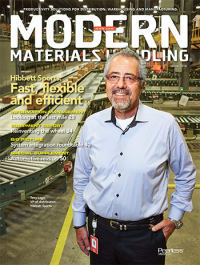From DC to Final Destination: Last Mile Dilemma
The race is on to close the last mile delivery gap, cut costs and improve customer service.
Latest Material Handling News
ProGlove and topsystem partner on hands-free picking solution CaPow’s power-in-motion solution eliminates charging downtime International Retailer Optimizes Efficiency Through Asset Lockers Writing the book on streamlined data capture 60 Seconds with Diego Vega from the Hanken School of Economics More Mobile & WirelessIn the telecommunications field, the last mile refers to the provisioning of high-speed, high-capacity information to every household. In the legal system, the last mile is the distance walked by a condemned person from his or her prison cell to the place of execution. And while the supply chain “last mile” isn’t quite as dramatic, it does represent that very important last step required to get a delivery into the hands of the end user/customer.
The last mile has always been a concern for companies that ship goods to end users, but the spotlight shining on it has become much brighter as the volume of e-commerce and direct-to-consumer shipments has grown. Used to describe the movement of goods from a transportation hub (i.e., a warehouse or DC) to the final destination (usually a customer’s home or business), the last mile plays an important part of any company’s transportation strategy in today’s competitive business environment.

“The final mile of delivery presents a unique set of challenges compared to the rest of the supply chain,” writes VDC Research’s Richa Gupta in “From the Last Mile to the Last Meter.” “Packages often do not reach their intended recipient on the first delivery attempt resulting in items being returned to distribution center hubs. This translates into increased costs for delivery service providers and reflects poorly on sellers, resulting in pronounced consumer dissatisfaction.”
Honeywell, which estimates that the last mile makes up 50% of total logistics costs on any shipment, says this segment of the supply chain is fraught with challenges, including congestion in urban areas, distance in remote areas, invalid or incorrect address details, hard-to-locate destinations, a lack of human presence to sign for deliveries, and even out-of-service elevators. Issues with the last mile can also be traced back to the warehouse and the DC, both or either of which play critical roles in the smooth overall running of the supply chain.
“The delivery and distribution processes are tied together and closely connected,” says Bruce Stubbs, director of supply chain marketing at Honeywell Sensing & Productivity Solutions. “For the last mile delivery to take place, things have to happen within the four walls to ensure that the packages are picked correctly, include the right type of information(i.e., delivery labels, correct addresses, etc.),and meet delivery windows.”
The race is on
The race to shorten the last mile is on. With an ever-growing volume of e-commerce sales, consumers, retailers and parcel service providers have all come to realize the glaring inefficiencies in the so-called last mile. “Explosive growth in the use of non-traditional retail avenues has exacerbated and exposed an already existing issue, ”says Gupta, director of AutoID and Data Capture at VDC. “This is also a huge cost component of the supply chain, representing an estimated 28% of the cost of delivery.”
Gupta says much of the concern over the last mile is directly related to the volume of goods that are now being shipped directly to consumers, and in a very personalized manner. These smaller, more customized orders have displaced the large, bulk, palletized shipments that once reigned in the typical DC. With the last stretch of the supply chain consuming 28% of the total delivery cost—and with 30% of shipments not making it to the end recipient on the first attempt—Gupta says these gaps present real opportunities for firms that want to trim costs and improve customer service levels.
The good news is that advances in technology are making it easier for companies to bridge the gaps in their last miles and do a better job of delivering those personalized, on-time experiences that their end users have come to expect. In the warehouse, for example, Gupta sees image-based data capture solutions as a particularly good investment for companies that want to not only be able to capture the data and the bar code, but that also want to capture an image of the product itself. The latter can be especially useful when dealing with issues like damaged goods.
“One of the biggest costs associated with delivery in this era of personalized customer service is the liability associated with damaged goods,” Gupta says. “Using image-based data capture devices, delivery personnel can capture the state of the product as it was delivered to the final consumer, so that all the liabilities associated with damaged goods can be determined at the right point in the supply chain.”
For the companies that have already made substantial investments in barcode scanning, printing and mobile solutions, Gupta says that the next step is to empower delivery personnel, DC staff and other users to capitalize on the features and applications of that equipment. Load planning and route mapping, for example, can be stream lined with the use of those technologies. “That’s still a work in progress,” says Gupta, “and something that companies are trying to perfect.”
Out in the field, Gupta also sees centralized distribution, networks and lockers gaining in popularity as companies continue to “perfect” their last mile strategies. Using lockers, for example, companies can drop off parcels for specific customers and give those recipients access to their parcels on their own terms. Gupta says the practice is catching on in Europe, where companies like DHL have recently starting using the strategy to solve their own last mile challenges. “I think this is something we’re going to see more of as companies try to address the acute challenges they’re running into—and particularly during the holiday season.”
More tech tools, please
Will Salter, CEO at Paragon Software Systems, says last mile-focused companies want to meet the seven distinct “Cs” of good customer service. The first three are choice (enabling customers to choose how, where and when they receive their deliveries), certainty (making sure that the customer’s choice and your promise to the customer are achievable), and communication (keeping the customer informed of progress throughout the order lifecycle). The last four Cs are control (putting the customer in control and enabling the customer to make changes to delivery requirements throughout the order lifecycle), convenience (providing choice, communication, control and certainty that delivers convenience to the customer throughout the life cycle of an order), confidence that the whole process delivers the customer offer and cost-efficiency.
To hit some or all seven Cs, Salter says more companies are using dynamic daily routing systems that work much differently than the “batch” solutions that many firms have traditionally used when scheduling their transportation. “In the past, companies used batch systems based on time cutoffs (for example: 6 p.m. Monday through Friday),” says Salter. “This approach is no longer effective.”
Dynamic systems help companies organize their morning and afternoon shipments, for instance, and then “operate on a sort of ‘bucket’ strategy for the actual deliveries,” says Salter. When a customer places an order online, the routes and schedules are developed automatically based on actual and attainable geographical routes. Salter says these types of technology tools help companies manage higher shipping volumes while maintaining good customer service levels.
Infusing technology like dynamic daily routing into the last mile also helps reduce costs, according to Salter, who points out that small-volume deliveries going out to a large number of locations next-day or even same-day can get pretty expensive—particularly for retailers. “While some retailer shave attempted to turn delivery services into a profit stream, not all customers are prepared to pay for deliveries,” says Salter. “As soon as you make a time/date promise to a customer, you introduce restrictions into the planning process.”
Creating a seamless experience
As companies continue to take steps to conquer their last mile transportation challenges, Stubbs says those making strides in this area are already seeing benefits like cost savings, fewer product returns, better visibility, happier customers and more streamlined supply chains. In some cases, all it takes is a simple shift away from manual, paper-based warehousing systems to start seeing improvements in this area.
“It all starts in the DC, where anything that’s being done on paper is slower and wrought with errors,” says Stubbs. “When you work off paper,” he explains, “you’re working more slowly than you would be if you were using directed system input, mobility devices, scanners and/or voice.”
Looking ahead, Gupta expects more companies to focus on improving their last mile delivery strategies. She says third-party logistics firms (3PLs) and e-tailers like Amazon are working hard to hone this area of the supply chain.
“The last mile is a sure and sharp method for companies that want to trim down their delivery-related costs,” says Gupta. “Many are turning to technology options that will help them alleviate the associated challenges while also using traditional options like private fleets (as in the case of Amazon) to work through the obstacles and create a more seamless experience for the end user.”
Companies mentioned in this article:
Honeywell Sensing & Productivity Solutions
Paragon Software Systems
VDC Research’s

Article Topics
Mobile & Wireless News & Resources
ProGlove and topsystem partner on hands-free picking solution CaPow’s power-in-motion solution eliminates charging downtime International Retailer Optimizes Efficiency Through Asset Lockers Writing the book on streamlined data capture 60 Seconds with Diego Vega from the Hanken School of Economics The Rebound: 3D Transformation at GE Appliances Barcoding, Inc. joins Graham Partners More Mobile & WirelessLatest in Materials Handling
Registration open for Pack Expo International 2024 Walmart chooses Swisslog AS/RS and software for third milk processing facility NetLogistik partners with Vuzix subsidiary Moviynt to offer mobility solutions for warehouses Materials Handling Robotics: The new world of heterogeneous robotic integration BSLBATT is looking for new distributors and resellers worldwide Lucas Watson appointed CSO for Körber’s Parcel Logistics business in North America Hyster recognizes Dealers of Distinction for 2023 More Materials HandlingAbout the Author
Subscribe to Materials Handling Magazine

Find out what the world's most innovative companies are doing to improve productivity in their plants and distribution centers.
Start your FREE subscription today.
April 2024 Modern Materials Handling

Latest Resources











